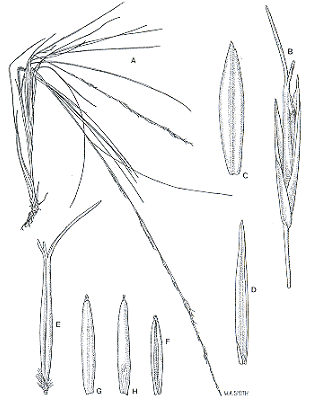Aristida thompsonii B.K.Simon. Austrobaileya
4: 145 (1994).
Classification. (GPWG 2001) : Subfamily
Aristidoideae. Aristideae.
Type of Basionym or
Protologue Information: Australia: Queensland: North Kennedy District: 9.5
km W of Homestead, 20.21S 1145.31E, 30 Aug 1992, E.J. Thompson & P.R.
Sharpe CHA232 (HT: BRI; IT: AD, CANB, DNA, K).
Key references
(books and floras): [2002] D.Sharp & B.K.Simon, AusGrass, Grasses of
Australia.
Illustrations:
[2005] K.Mallet (ed.), Flora of Australia 44B: Poaceae 3 (Fig.
13).
Derivation: in
honor of Edward John Thompson (1949-) Australian ecologist.
Habit.
Perennial. Culms erect, 20–40 cm tall, 1–1.5 mm diam., 3–4 -noded. Mid-culm
internodes glabrous. Mid-culm nodes glabrous. Lateral branches sparsely
branched or branched. Leaves mostly basal. Leaf-sheaths smooth, glabrous on
surface. Ligule a fringe of hairs, 0.5 mm long. Leaf-blades conduplicate or
involute or convolute, 10–25 cm long, 0.5–0.75 mm wide. Leaf-blade surface
scaberulous, indumented.
Inflorescence.
Inflorescence compound, a panicle. Panicle linear, 6–10 cm long, 0.3 cm wide.
Spikelets.
Spikelets pedicelled. Fertile spikelets 1-flowered, comprising 1 fertile
floret(s), without rachilla extension, lanceolate, terete, 6–7 mm long.
Glumes.
Glumes similar, thinner than fertile lemma. Lower glume lanceolate, membranous,
1 -nerved. Lower glume surface glabrous. Lower glume apex muticous. Upper glume
lanceolate, 6–7 mm long, membranous, 1 -nerved. Upper glume surface asperulous,
glabrous. Upper glume apex entire, muticous.
Florets.
Fertile lemma 5.5–6 mm long, without keel, 5 -nerved. Lemma apex awned, 3
-awned. Median (principal) awn without a column. Lateral lemma awns present.
Anthers 3. Grain 4.5 mm long.
Continental
Distribution: Australasia.
Australian
Distribution: Queensland.
Queensland:
North Kennedy.
Notes.
Bluish green leaves due to being glaucous.
Restricted to type
locality. Patchy heath of Kunzea callida on flat rock area. Flowering
and fruiting August.



